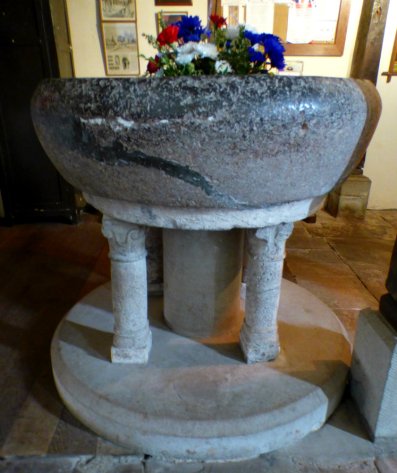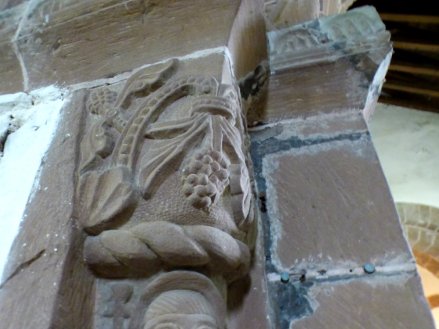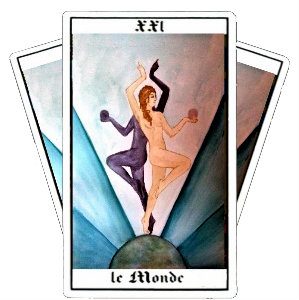
***
It was either going to be spectacular… or very plain. Probably the latter, as we have found that with the highly decorated churches, it tends to be one or the other, inside or out. It was, then, no surprise to open the door to a calm and simple interior full of soft light. Except… well, the font was pretty spectacular in its own way. The huge bowl dates back to a time when baptism involved more than a trickle of holy water on the brow. It still had the place for the locks too… once upon a time, holy water could be stolen for purposes more akin to sorcery than religion. And it was older than the church… much older in fact and may have belonged to a previous, Saxon church on the site, making it well over a thousand years that it has been used within the community. It used to stand under the chancel arch, with the Devil’s Door to the north so the devil could escape the touch of baptismal water.
***

***
It is a beautiful church, its simplicity and serenity untouched by time and the passing of countless feet. But its simplicity is deceptive, for on closer inspection, it begins to yield its treasures.
***

***
It is built as a three-cell church, with nave, chancel and an unusual semicircular apse. The chancel arches and ribs are of the same red sandstone as the exterior and the carvings are just as well preserved. The arch itself is decorated simply, with typical Norman geometric patterns.
***

***
The capitals of the columns are carved with the ‘True Vine’ that represents Jesus as the Son of God. The vine bears fruit and is the same pattern as the latticework carved on the west window and the foliage coming from the mouths of the Green Men. The symbolism of life and rebirth is obvious and harks back to even older faiths. Even in Egypt, Osiris was depicted as green.
***

***
Beneath the capitals are carved figures of saints. While some look like ecclesiastics, and one holds a key so is presumably St Peter, the others remain unidentified.
***

***
The inspiration for the arch is thought to have been taken from the Silversmiths’ Gate at Santiago de Compostela, one of the most important places of Christian pilgrimage. The figures are curious. The bottom two appear to be tonsured monks and are smaller than the saints. In many ancient cultures… like the Egyptian and mediaeval paintings that we can still see so clearly… importance was denoted by relative size. I have to wonder if here the carvings are not reminding the congregation that the exoteric Church is of less importance than the saints it ‘supports’… that the earthly Church is less than Divinity. A reminder of humility, at a time when the priesthood held much power in the land.
***

***
Beyond the arch stands a very curious holy water stoup that would have once stood at the doors of the church for the congregation. It was brought from a chapel in the nearby Forest of Treville, near Wormbridge… a name to conjure with, given the plethora of dragons here… and is older even than the font.
***

***
A bowl upon an inverted bowl, with hands resting as if upon a pregnant belly. A girdle beneath the belly has four serpents heads hanging from it. It is not Norman. It is probably not even Saxon, but may to be even older than that. You have to ask yourself, given the symbolism, if it was ever a Christian piece to begin with…
***

***
The apse holds the altar and it is a beautiful place. There are only three small stained glass windows in the church, all Victorian, arranged around the semicircle of the apse. The Lamb of God to the left, King David, complete with Goliath’s severed head to the right and presumably King Solomon in the centre. The figures are each set within a vesica, a feminine symbol, between encircled, leafy crosses. The windows are by Augustus Pugin, best known for the interior design of the Palace of Westminster.
***

***
Few of these early apses survive and we see them most often on churches with Templar associations. Most have been replaced with rectangular chancels, yet there is something very personal about the space. The curving ceiling represented the arch of heaven to the early Christians and to stand between the pillars before the altar seems an intimate glimpse of union with the divine, an invitation to a higher state of being.
***

***
Four stone ribs support the arch, carved like flowing water issuing from the mouths of four heads. Four seems an important number in this particular church, and it had kept cropping up. We do not know what these four heads and streams represent. They could be the four rivers that flowed from the Garden of Eden. They might refer to four rivers that flow into the Wormbrook close by. Or they might have something to do with the stream of pure water that follows the centre line of the church, rising immediately below these four heads. Oddly enough, the church’s own information board says that dowsers have reported that four streams flow in to this point.
***

***
It is just a village church, a small place in the middle of fields that has preserved some of the most incredible stonework… as well as an atmosphere of gentle peace. Yet it was not always so. Once, the church served a noble lord and his household and the uneven fields still hold traces that speak of the daily lives of the villagers who also served. We left the cool interior of the little church. Outside, there was yet more to see… though we would have to read the land, now, not the stones.
***




Really interesting to free associate…
The stoup is especially intringuing.
If the four streams where the arches come together evoke the rivers of Eden, the serpents might be guardians of Eden as well. Holders of knowledge.
The stoup’s shape calls to mind the chalices (cups) shapes in the Rider Waite deck…
And that plus the feminine qualities evoke the symbolism of the Grail.
Definitely wonderful things to ponder 🙂
LikeLike
The stoup is incredible, Darcy…and not at all what you would expect to find. It definitely doesn’t seem to fit with traditional Christian symbolism.
LikeLike
It was the water stoup for me, too, which was the most fascinating and intriguing.
LikeLike
It poses so many questions, that stoup… and looks far more like a gravid goddess than a container for Christian holy water…
LikeLike
The carvings are amazing.
LikeLiked by 1 person
They really are, Mary.
LikeLike
Where is this one, Sue. I love these carvings. Among the best I’ve seen.
LikeLike
The church is at Kilpeck, Herefordshire, not far from the Welsh border.
LikeLike
Reblogged this on Stuart France.
LikeLiked by 1 person